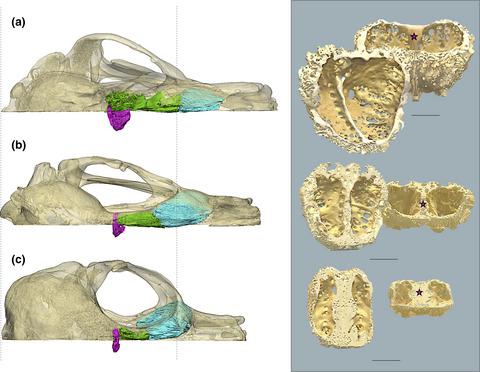当前位置:
X-MOL 学术
›
Ecol. Evol.
›
论文详情
Our official English website, www.x-mol.net, welcomes your feedback! (Note: you will need to create a separate account there.)
Olfaction at depth: Cribriform plate size declines with dive depth and duration in aquatic arctoid carnivorans.
Ecology and Evolution ( IF 2.6 ) Pub Date : 2020-06-23 , DOI: 10.1002/ece3.6343 Deborah J Bird 1 , Iman Hamid 1 , Lester Fox-Rosales 1 , Blaire Van Valkenburgh 1
Ecology and Evolution ( IF 2.6 ) Pub Date : 2020-06-23 , DOI: 10.1002/ece3.6343 Deborah J Bird 1 , Iman Hamid 1 , Lester Fox-Rosales 1 , Blaire Van Valkenburgh 1
Affiliation

|
It is widely accepted that obligate aquatic mammals, specifically toothed whales, rely relatively little on olfaction. There is less agreement about the importance of smell among aquatic mammals with residual ties to land, such as pinnipeds and sea otters. Field observations of marine carnivorans stress their keen use of smell while on land or pack ice. Yet, one dimension of olfactory ecology is often overlooked: while underwater, aquatic carnivorans forage “noseblind,” diving with nares closed, removed from airborne chemical cues. For this reason, we predicted marine carnivorans would have reduced olfactory anatomy relative to closely related terrestrial carnivorans. Moreover, because species that dive deeper and longer forage farther removed from surface scent cues, we predicted further reductions in their olfactory anatomy. To test these hypotheses, we looked to the cribriform plate (CP), a perforated bone in the posterior nasal chamber of mammals that serves as the only passageway for olfactory nerves crossing from the periphery to the olfactory bulb and thus covaries in size with relative olfactory innervation. Using CT scans and digital quantification, we compared CP morphology across Arctoidea, a clade at the interface of terrestrial and aquatic ecologies. We found that aquatic carnivoran species from two lineages that independently reinvaded marine environments (Pinnipedia and Mustelidae), have significantly reduced relative CP than terrestrial species. Furthermore, within these aquatic lineages, diving depth and duration were strongly correlated with CP loss, and the most extreme divers, elephant seals, displayed the greatest reductions. These observations suggest that CP reduction in carnivorans is an adaptive response to shifting selection pressures during secondary invasion of marine environments, particularly to foraging at great depths. Because the CP is fairly well preserved in the fossil record, using methods presented here to quantify CP morphology in extinct species could further clarify evolutionary patterns of olfactory loss across aquatic mammal lineages that have independently committed to life in water.
中文翻译:

深度嗅觉:水生北极食肉动物的筛状板尺寸随着潜水深度和持续时间而减小。
人们普遍认为,专性水生哺乳动物,特别是齿鲸,对嗅觉的依赖相对较少。对于与陆地仍有联系的水生哺乳动物(例如鳍足类动物和海獭),嗅觉的重要性尚未达成共识。对海洋食肉动物的实地观察强调了它们在陆地或浮冰上对气味的敏锐运用。然而,嗅觉生态学的一个方面经常被忽视:在水下,水生食肉动物“鼻盲”地觅食,在潜水时鼻孔闭合,远离空气中的化学信号。因此,我们预测,相对于密切相关的陆地食肉动物,海洋食肉动物的嗅觉解剖结构会有所减少。此外,由于潜入更深、更长的饲料的物种远离表面气味线索,我们预测它们的嗅觉解剖结构会进一步减少。为了检验这些假设,我们研究了筛板(CP),这是哺乳动物后鼻腔中的一种穿孔骨,它是嗅觉神经从外周穿过到嗅球的唯一通道,因此其大小与相对嗅觉有关。神经支配。使用 CT 扫描和数字量化,我们比较了 Arctoidea 的 CP 形态,Arctoidea 是陆地和水生生态交界处的一个分支。我们发现,独立重新入侵海洋环境的两个谱系的水生食肉动物物种(鳍足类和鼬科)的相对 CP 显着低于陆地物种。此外,在这些水生世系中,潜水深度和持续时间与CP损失密切相关,最极端的潜水者象海豹的CP损失最大。这些观察结果表明,食肉动物的CP减少是对海洋环境二次入侵期间选择压力变化的适应性反应,特别是在深海觅食时。由于 CP 在化石记录中保存得相当完好,因此使用此处介绍的方法来量化灭绝物种的 CP 形态可以进一步阐明独立致力于水中生活的水生哺乳动物谱系的嗅觉丧失的进化模式。
更新日期:2020-07-30
中文翻译:

深度嗅觉:水生北极食肉动物的筛状板尺寸随着潜水深度和持续时间而减小。
人们普遍认为,专性水生哺乳动物,特别是齿鲸,对嗅觉的依赖相对较少。对于与陆地仍有联系的水生哺乳动物(例如鳍足类动物和海獭),嗅觉的重要性尚未达成共识。对海洋食肉动物的实地观察强调了它们在陆地或浮冰上对气味的敏锐运用。然而,嗅觉生态学的一个方面经常被忽视:在水下,水生食肉动物“鼻盲”地觅食,在潜水时鼻孔闭合,远离空气中的化学信号。因此,我们预测,相对于密切相关的陆地食肉动物,海洋食肉动物的嗅觉解剖结构会有所减少。此外,由于潜入更深、更长的饲料的物种远离表面气味线索,我们预测它们的嗅觉解剖结构会进一步减少。为了检验这些假设,我们研究了筛板(CP),这是哺乳动物后鼻腔中的一种穿孔骨,它是嗅觉神经从外周穿过到嗅球的唯一通道,因此其大小与相对嗅觉有关。神经支配。使用 CT 扫描和数字量化,我们比较了 Arctoidea 的 CP 形态,Arctoidea 是陆地和水生生态交界处的一个分支。我们发现,独立重新入侵海洋环境的两个谱系的水生食肉动物物种(鳍足类和鼬科)的相对 CP 显着低于陆地物种。此外,在这些水生世系中,潜水深度和持续时间与CP损失密切相关,最极端的潜水者象海豹的CP损失最大。这些观察结果表明,食肉动物的CP减少是对海洋环境二次入侵期间选择压力变化的适应性反应,特别是在深海觅食时。由于 CP 在化石记录中保存得相当完好,因此使用此处介绍的方法来量化灭绝物种的 CP 形态可以进一步阐明独立致力于水中生活的水生哺乳动物谱系的嗅觉丧失的进化模式。



























 京公网安备 11010802027423号
京公网安备 11010802027423号